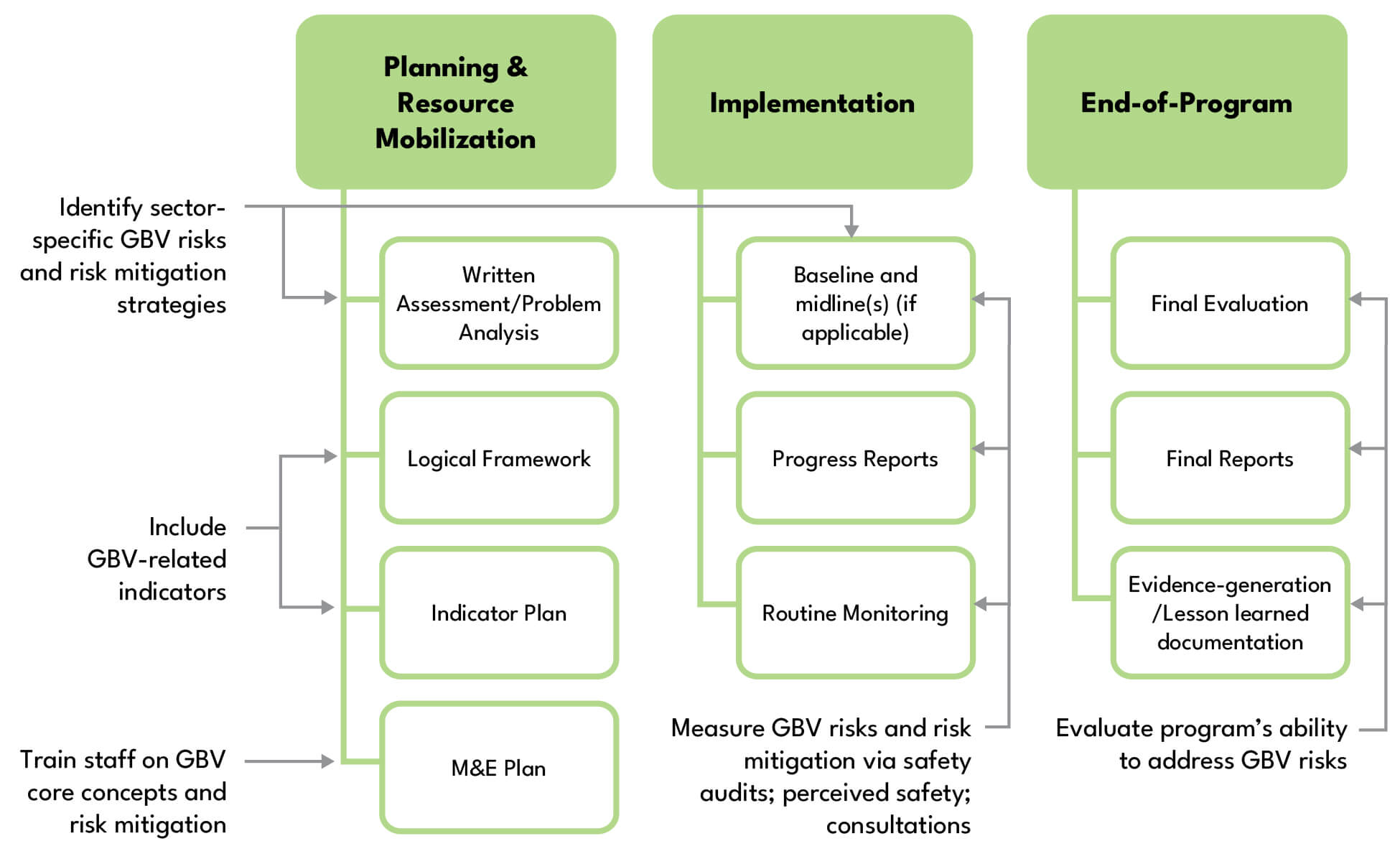Monitoring and evaluation for GBV risk mitigation focuses on: 1) monitoring known and unknown GBV risks relevant to the sector/intervention and 2) evaluating and/or assessing the outcomes and effectiveness of GBV risk mitigation strategies.
Monitoring and evaluation for GBV risk mitigation focuses on: 1) monitoring known and unknown GBV risks relevant to the sector/intervention and 2) evaluating and/or assessing the outcomes and effectiveness of GBV risk mitigation strategies.
This information is critical to understanding any changes or course corrections we might need to make, as well as to documenting the outcomes and impact of GBV risk mitigation activities, continuing to build the global evidence base for this work.
CAUTION: Direct monitoring and data collection about GBV incidents can pose serious risks to program participants and enumerators and is not necessary for GBV risk mitigation. Specifically, collecting data on GBV incidents can pose risks including:
In addition, it’s important to understand that GBV incidents are typically underreported, making incident data unreliable for programming decisions. Instead, focus on monitoring GBV risks and evaluating the GBV risk mitigation strategies that you’ve put in place.

It can inadvertently pose risks of stigma and reprisal to affected populations and/or enumerators.
Underreporting of GBV incidents is chronic due to a number of factors resulting in prevalence data that is of poor quality and not comprehensive.
It is important to ensure that GBV risks and the outcomes of the GBV risk mitigation strategies in place are consistently monitored and evaluated.
Integrating GBV risk mitigation into monitoring and evaluation serves two critical purposes:

An effective M&E framework focuses on understanding the degree to which our programming is:
You can measure one or more of these four categories by adapting the suggested methodology below for your context.
There are multiple ways to measure reduction in GBV risks without asking direct questions about GBV incidents or prevalence. For example, we can measure:
Understanding safety perceptions is crucial to GBV risk mitigation because program participants who don’t feel safe accessing services simply won’t use them.
If safety concerns remain unmonitored and unaddressed, humanitarian programming will fail to reach the most vulnerable populations, potentially cause more harm than good, and likely fall short of meeting targets.
“Safe” programming:
Regular application of the AAAQ framework can help identify how safety risks affect service access and how services themselves might create new risks, or fail to account for existing risks. Sample indicators for safety perceptions include:
These indicators and perceptions can be verified through ongoing focus group discussions with women and girls and safety audits.
Access barriers for women, girls, and other vulnerable groups can be measured by integrating indicators into baseline, midline, and endline surveys on user satisfaction in accessing services. For example:
Refer to/contextualize the AAAQ framework to assess for different types of access barriers, relevant to your contextongoing focus group discussions with women and girls and safety audits.
Improving the safety and accessibility of programming for all participants - including the most vulnerable/hardest to reach - should also help to ensure that programming targets are fully reached, and therefore also improve sector-specific outcomes.
Specific measurement tools for sector-specific outcomes will depend on sector and context, but examples include:
Reduction in sector-related risky coping mechanisms with women and girls and safety audits.
TIP: Each sector-specific GBV Guidelines Thematic Area Guide (TAG) includes a monitoring and evaluation section with indicators that can help track results, chart outcomes, and measure progress while considering diverse perspectives. You can adapt these indicators to your program/context where needed.
There are multiple entry points for GBV risk mitigation monitoring and evaluation across the humanitarian program cycle. The graphic below presents a number of common entry points from planning and resource mobilization, throughout implementation, and at the end of the program. Throughout the program cycle, it is important to ensure that project monitoring plans regularly identify sector-specific GBV risks and monitor GBV risk mitigation strategies.

Monitor:
By integrating GBV risk mitigation into your M&E framework, you can ensure that your programming remains safe, accessible, and accountable to affected populations throughout the program cycle.
This site is always being updated, so please check back often for new additions, tools, and resources!
Copyright © 2025 • GBV Guidelines